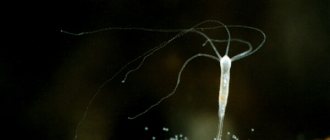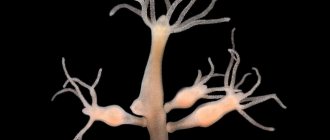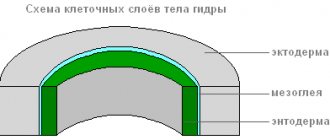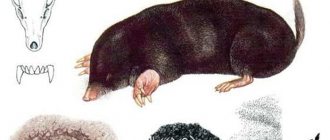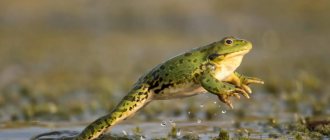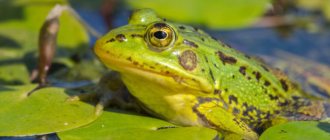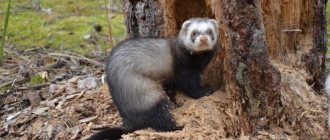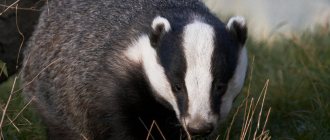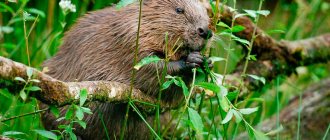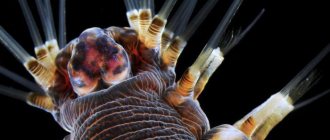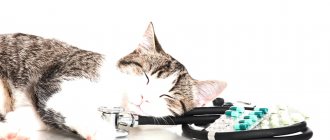General structure
The hydra's body looks like an oblong sac, the walls of which consist of two layers of cells - ectoderm and endoderm.
Between them lies a thin gelatinous non-cellular layer - mesoglea, which serves as a support.
The ectoderm forms the covering of the animal’s body and consists of several types of cells: epithelial-muscular, intermediate and stinging.
The most numerous of them are epithelial-muscular.
Ectoderm
epithelial muscle cell
Due to the muscle fibers lying at the base of each cell, the hydra's body can contract, lengthen and bend.
Between the epithelial-muscle cells there are groups of small, round cells with large nuclei and a small amount of cytoplasm, called intermediate cells.
When the hydra's body is damaged, they begin to grow and divide rapidly. They can transform into other types of cells in the hydra body, except for epithelial-muscular ones.
The ectoderm contains stinging cells that serve for attack and defense. They are mainly located on the tentacles of the hydra. Each stinging cell contains an oval capsule in which the stinging filament is coiled.
Structure of a stinging cell with a coiled stinging thread
If prey or an enemy touches a sensitive hair located outside the stinging cell, in response to irritation the stinging thread is ejected and pierces the body of the victim.
Structure of a stinging cell with discarded stinging thread
Through the thread channel, a substance that can paralyze the victim enters the victim’s body.
There are several types of stinging cells. The threads of some pierce the skin of animals and introduce poison into their bodies. The threads of others are wrapped around the prey. The threads of the third are very sticky and stick to the victim. Usually the hydra “shoots” several stinging cells. After the shot, the stinging cell dies. New stinging cells are formed from intermediate ones.
The structure of the inner layer of cells
Endoderm lines the entire intestinal cavity from the inside. It consists of digestive muscle and glandular cells.
Endoderm
Digestive system
There are more digestive muscle cells than others. Their muscle fibers are capable of contraction. When they shorten, the hydra's body becomes thinner. Complex movements (movement by “tumbling”) occur due to contractions of muscle fibers of ectoderm and endoderm cells.
Each of the digestive-muscle cells of the endoderm has 1-3 flagella. Vibrating flagella create a current of water, which drives food particles towards the cells. Digestive muscle cells of the endoderm are capable of forming pseudopods, capturing and digesting small food particles in the digestive vacuoles.
The structure of the digestive muscle cell
Glandular cells in the endoderm secrete digestive juice into the intestinal cavity, which liquefies and partially digests food.
The structure of the glandular cell
Prey is captured by the tentacles using stinging cells, the venom of which quickly paralyzes small victims. By coordinated movements of the tentacles, the prey is brought to the mouth, and then, with the help of body contractions, the hydra is “put on” the victim. Digestion begins in the intestinal cavity (cavitary digestion) and ends inside the digestive vacuoles of the epithelial-muscle cells of the endoderm (intracellular digestion). Nutrients are distributed throughout the hydra's body.
When the digestive cavity contains remains of the prey that cannot be digested, and waste products of cellular metabolism, it contracts and empties.
Breath
Hydra breathes oxygen dissolved in water. She has no respiratory organs, and she absorbs oxygen over the entire surface of her body.
Circulatory system
Absent.
Selection
The release of carbon dioxide and other unnecessary substances formed during life processes is carried out from the cells of the outer layer directly into the water, and from the cells of the inner layer into the intestinal cavity, then out.
Nervous system
Below the skin-muscle cells are star-shaped cells. These are nerve cells (1). They connect with each other and form a nerve network (2).
Nervous system and irritability of the hydra
If you touch the hydra (2), then excitation (electrical impulses) occurs in the nerve cells, which instantly spreads throughout the entire nervous network (3) and causes contraction of the skin-muscle cells and the entire body of the hydra shortens (4). The response of the hydra body to such irritation is an unconditioned reflex.
Classification
Hydra is a representative of the Coelenterates; belongs to the Cnidaria type and the Hydroid class.
Coelenterates are bilayered multicellular animals with radial symmetry and a single body cavity - the intestinal cavity (hence the name). The intestinal cavity is connected to the external environment only through the mouth. Nerve cells form the nerve plexus. All coelenterates are characterized by the presence of stinging cells. All coelenterates are predators. There are more than 9,000 species of coelenterates; they live exclusively in the aquatic environment, most of which are distributed primarily in the seas.
On this page there is material on the following topics:
Characteristics of a hydra cell
Hydra adaptation
What does a freshwater polyp breathe?
Hydroid polyps are characterized by the following:
Brief description of the structure of hydra
Questions about this material:
What environmental factors does the life of a hydra depend on?
Why do many fish fry, having captured a hydra in their mouths, throw it away?
How does a hydra breathe?
Sex cells
With the approach of cold weather in the fall, germ cells are formed from intermediate cells in the ectoderm of the hydra.
There are two types of germ cells: eggs, or female germ cells, and sperm, or male germ cells.
The eggs are located closer to the base of the hydra, sperm develop in tubercles located closer to the mouth.
The egg cell of a hydra is similar to an amoeba. It is equipped with pseudopods and grows rapidly, absorbing neighboring intermediate cells.
The structure of the hydra egg cell
The structure of the hydra sperm
Spermatozoa resemble flagellated protozoa in appearance. They leave the hydra's body and swim using a long flagellum.
Lifespan
Speaking about what a hydra is, it is important to talk about the duration of the life cycle of individuals.
Back in the nineteenth century, it was hypothesized that the hydra was immortal. Over the course of the next century, some scientists tried to prove it, and some tried to refute it. Only in 1997 was it finally proven by Daniel Martinez through an experiment that lasted four years. There is also an opinion that the immortality of the hydra is associated with high regeneration. And the fact that adults die in the rivers of the central zone in winter is most likely due to a lack of food or exposure to unfavorable factors.
Fertilization. Reproduction
The sperm swims up to the hydra with the egg cell and penetrates inside it, and the nuclei of both sex cells merge. After this, the pseudopods are retracted, the cell is rounded, a thick shell is released on its surface - an egg is formed. When the hydra dies and is destroyed, the egg remains alive and falls to the bottom. With the onset of warm weather, the living cell located inside the protective shell begins to divide, the resulting cells are arranged in two layers. From them a small hydra develops, which comes out through a break in the egg shell. Thus, the multicellular animal hydra at the beginning of its life consists of only one cell - an egg. This suggests that the ancestors of Hydra were single-celled animals.
Asexual reproduction of hydra
Under favorable conditions, hydra reproduces asexually. A bud forms on the animal’s body (usually in the lower third of the body), it grows, then tentacles form and a mouth breaks through. The young hydra buds from the mother's body (in this case, the mother and daughter polyps are attached with tentacles to the substrate and pull in different directions) and leads an independent lifestyle. In autumn, hydra begins to reproduce sexually. On the body, in the ectoderm, gonads are formed - sex glands, and in them, germ cells develop from intermediate cells. When hydra gonads form, a medusoid nodule is formed. This suggests that the hydra gonads are highly simplified sporifers, the last stage in the series of transformation of the lost medusoid generation into an organ. Most species of hydra are dioecious; hermaphroditism is less common. Hydra eggs grow rapidly by phagocytosing surrounding cells. Mature eggs reach a diameter of 0.5-1 mm. Fertilization occurs in the body of the hydra: through a special hole in the gonad, the sperm penetrates the egg and merges with it. The zygote undergoes complete uniform fragmentation, as a result of which a coeloblastula is formed. Then, as a result of mixed delamination (a combination of immigration and delamination), gastrulation occurs. A dense protective shell (embryotheca) with spine-like outgrowths is formed around the embryo. At the gastrula stage, the embryos enter suspended animation. Adult hydras die, and the embryos sink to the bottom and overwinter. In the spring, development continues, in the parenchyma of the endoderm, an intestinal cavity is formed by divergence of cells, then the rudiments of tentacles are formed, and a young hydra emerges from under the shell. Thus, unlike most marine hydroids, hydra does not have free-swimming larvae and its development is direct.
Nutrition process
This miniature creature is a real predator. It is very interesting to find out what freshwater hydra eats. The water is home to many small animals: cyclops, ciliates, and crustaceans. They serve as food for this creature. Sometimes it can eat larger prey, such as small worms or mosquito larvae. In addition, these coelenterates cause great damage to fish ponds, because caviar becomes one of the things that hydra feeds on.
In the aquarium you can watch in all its glory how this animal hunts. The hydra hangs with its tentacles down and at the same time arranges them in the form of a network. Her torso sways slightly and describes a circle. Prey swimming nearby touches the tentacles and tries to escape, but suddenly stops moving. The stinging cells paralyze her. Then the coelenterate creature pulls it to its mouth and eats it.
If the animal has eaten well, it swells. This creature can devour prey that is larger than itself. Its mouth can open very wide, sometimes part of the prey’s body can be clearly seen from it. After such a spectacle, there is no doubt that the freshwater hydra is a predator in its feeding method.
Regeneration
Hydra has a very high ability to regenerate. When cut crosswise into several parts, each part restores the “head” and “leg”, maintaining the original polarity - the mouth and tentacles develop on the side that was closer to the oral end of the body, and the stalk and sole develop on the aboral side of the fragment. The whole organism can be restored from individual small pieces of the body (less than 1/100 of the volume), from pieces of tentacles, and also from a suspension of cells. Moreover, the regeneration process itself is not accompanied by increased cell division and is a typical example of morphallaxis.
What does hydra eat?
The hydra's diet is characterized by a diet consisting of miniature inhabitants of reservoirs - ciliates, water fleas, planktonic crustaceans, insects, fish fry, and worms.
If the prey is small, the hydra swallows it whole. If the prey is large, the predator is able to open its mouth wide and significantly stretch its body.
Movement
In a calm state, the tentacles extend several centimeters. The animal slowly moves them from side to side, lying in wait for prey. If necessary, the hydra can move slowly.
"Walking" mode of transportation
"Walking" method of movement of the hydra
Having curved its body (1) and attached its tentacles to the surface of an object (substrate), the hydra pulls the sole (2) to the front end of the body. Then the walking movement of the hydra is repeated (3,4).
